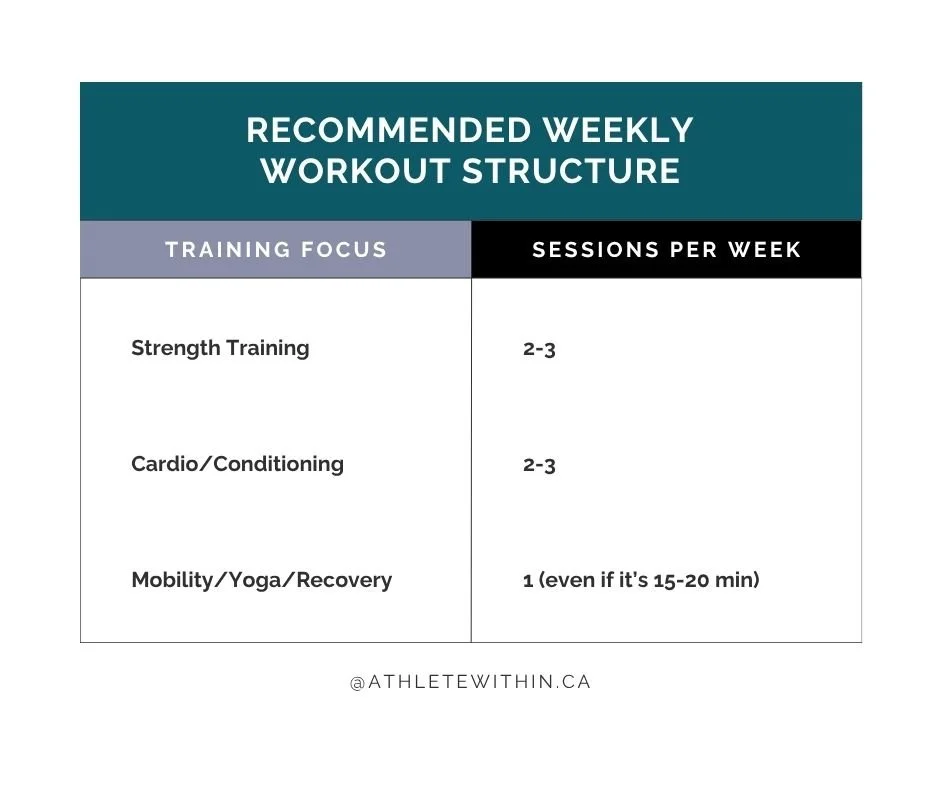How Often Should You Strength Train?
You’re active, committed, and getting workouts in most days of the week. Maybe your routine includes a few runs, cycling workouts, or Peloton rides, plus the occasional plank or set of bicep curls. You’re doing something—but is it enough? And more importantly, is it the right kind of training to help you feel strong, move well, and stay injury-free?
As athletes, weekend warriors, and lifelong movers, the goal isn’t just to stay busy—it’s to train with purpose. And the right balance of strength training workouts can be the difference between nagging aches and consistent, pain-free performance.
It’s a question we hear all the time:
“How many days a week should I strength train to see results?”
Like most things in fitness, the answer is: it depends—especially on what your current routine looks like. If your workouts are mostly cardio-based—running, spinning, or high-intensity interval training (HIIT)—you’re missing out on the full benefits of strength training for long-term health. Conditioning is important, but building lasting strength and resilience requires focused, progressive strength workouts that challenge your muscles and support long-term performance.
So, How Much Strength Training Is Enough?
If you're just getting started, even a small amount of strength training goes a long way. But if you're already active—whether that’s road cycling, marathon training, or team sports like hockey or soccer—and want to build strength, the research is clear:
✅ Two to three strength training sessions per week is the sweet spot for most people.
Training more than once a week leads to significantly better strength gains, but the benefits tend to level off after three sessions.
Hitting each major muscle group twice a week is more effective than once, and spacing your workouts across the week helps your body recover and grow.
The key takeaway: Progress doesn’t come from doing more — it comes from training with strategy and purpose. Consistency, progressive overload, and training volume matter more than simply working out every day.
Does Running or Cycling Count as Strength Training?
It’s a common belief — and while activities like running and cycling can build muscular endurance, they don’t develop true muscular strength the way most people think.
Here’s why:
1. Endurance ≠ Strength
Cardio uses light resistance over long durations. Great for stamina — but not for building lean muscle or max strength.
2. Resistance Builds Strength
Your muscles need external resistance to grow. That could be weights, bands, or bodyweight exercises — but it has to progressively challenge your muscles.
3. Strength Requires Effort, Not Just Fatigue
Just because something feels hard doesn’t mean it builds strength. True strength training involves short, focused sets where your muscles are pushed close to failure.
4. Muscle Is Long-Term Health Insurance
Muscle supports your metabolism, protects your joints, strengthens your bones, and helps you stay independent as you age. Cardio helps your heart and lungs. Strength training supports everything else.
3 Strength Benchmarks to Test Your Readiness for Sport
Not sure if your current strength training routine is working? These simple strength benchmarks can help:
Back Squat
If you can’t squat 1 to 1.5 times your body weight, your lower-body strength might need improvement for sprinting, jumping, and change of direction.
Chin-Up
If you can’t perform at least one chin-up with good form, your upper-body pulling strength likely needs work — essential for posture, shoulder stability, and grip strength.
Plank
If you can’t hold a plank for 30 to 90 seconds with proper form, your core stability and endurance may be holding back your performance — and increasing injury risk.
The Best Workout Plan? A Balanced One
This isn’t about choosing strength over cardio — both are important. The real key is finding a training plan that balances your goals, body, and lifestyle.
Here’s a simple weekly workout structure we recommend:
This kind of training plan helps you stay strong, conditioned, mobile, and injury-resistant — without burnout or overtraining.
Final Thoughts on Strength Training Frequency
Fitness doesn’t need to be extreme. You don’t have to live in the gym to see real results — but you do need a strength training plan that’s consistent, focused, and tailored to your goals.
Just two to three strength training sessions per week can dramatically improve how you feel, move, and perform — both in sport and everyday life.
References
Ralston, G. W., Kilgore, L., Wyatt, F. B., & Baker, J. S. (2017). The effect of weekly set volume on strength gain: A meta-analysis. Sports Medicine, 47(12), 2585–2601.
Grgic, J., Schoenfeld, B. J., Davies, T. B., Lazinica, B., Krieger, J. W., & Pedisic, Z. (2018). Effect of resistance training frequency on gains in muscular strength: A systematic review and meta-analysis. Sports Medicine, 48(5), 1207–1220.
Schoenfeld, B. J., Ogborn, D. I., & Krieger, J. W. (2015). Effect of repetition duration during resistance training on muscle hypertrophy: A systematic review and meta-analysis. Sports Medicine, 45(4), 577–585.
STACEY CARSWELL
Stacey Carswell is a Certified Strength and Conditioning Specialist and Personal Trainer dedicated to helping athletes and active individuals move better, feel stronger, and perform their best at any stage of life. With a background in fitness, rehab, and wellness promotion, she brings a thoughtful, science-based approach to every client she works with. Learn more about Stacey and her coaching philosophy here.
Disclaimer:
The information provided in this blog is for general educational purposes only and is not intended as medical or professional advice. Always consult with a healthcare professional or certified trainer before beginning any new exercise program or making significant changes to your diet or fitness routine. The author is not responsible for any injuries or health issues that may arise from following the advice provided.






